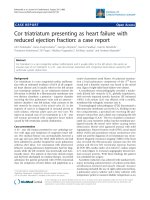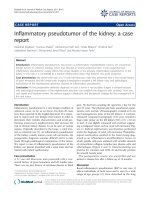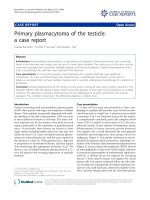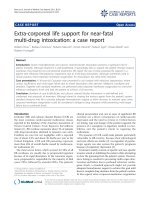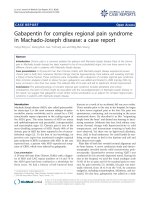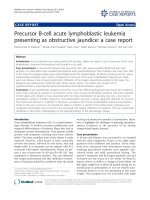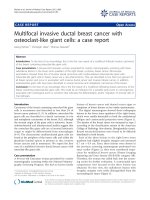Báo cáo y học: " Abscopal effect of radiation on lung metastases of hepatocellular carcinoma: a case report" pptx
Bạn đang xem bản rút gọn của tài liệu. Xem và tải ngay bản đầy đủ của tài liệu tại đây (1.61 MB, 4 trang )
CAS E REP O R T Open Access
Abscopal effect of radiation on lung metastases
of hepatocellular carcinoma: a case report
Kae Okuma
1
, Hideomi Yamashita
1*
, Yuzuru Niibe
2
, Kazushige Hayakawa
2
, Keiichi Nakagawa
1
Abstract
Introduction: The abscopal effect is the effect of radiation therapy at a site distant to the area of irradiation. This is
not a common event and has not been clearly defined, resulting in few reported cases in the literature . We discuss
this phenomenon in a patient with hepatocellular carcinoma.
Case presentation: A 63-year-old Japanese man underwent extended right hepatic lobectomy for hepatocellular
carcinoma. During his follow-up examination, a single lung metastasis and a single mediastinal lymph node
metastasis were found. Trans-catheter arterial embolization was initially attempted to treat the mediastinal tumor,
however this approach failed to take effect and carried risks of spinal artery embolism. External-beam irradiation,
with a dose of 2.25 Gy per fraction, was performed using an antero-posterior parallel-opposed technique (total
dose, 60.75 Gy). A computed tomography scan performed one month after starting radiotherapy showed a
remarkable reduction of the mediastinal lymph node metastasis. In addition to this, we observed spontaneous
shrinking of the lung metastasis, which was located in the right lower lobe and out of the radiation field. No
chemotherapy was given during the period. There has been no recurrence of either the lung metastasis or the
mediastinal lymph node metastasis during a follow-up 10 years after the radiotherapy.
Conclusion: We observed a rare abscopal effect in a site distant from the area of irradiation. Irradiation of the
mediastinum resulted in tumor mass regression in the untreated lung tumor.
Introduction
An abscopal effect has been defined as a reaction out-
side an irradiated area but within the same organism
[1], that can result in a tumor in a non-irradiated area
being spontaneously reduced. Since the first report of an
abscopal effect by Mole in 1953 [2], several other cases
have been reported in malignant lymphoma [3-5], hepa-
tocellular carcinoma (HCC) [6] and malignant mela-
noma [7]. In 2007, Takaya et al. described an abscopal
effect in a case of toruliform para-aortic lymph node
metastasis in a patient with advanced uterine cervical
carcinoma. This patient was treated with external
whole-pelvis and intra-cavitary irradiation to the pri-
mary pelvic lesion, successfully resulting in di sappear-
ance of the l esion. Moreover, para-aortic lymph node
metastases outside the irradiated field also spo nta-
neously disappeared [8].
The mechanism of the abscopal effect has not been
clearly defined. We report here the case of a patient
who showed an abscopa l effect on lung metastases of
HCC.
Case presentation
A Japanese man, who had been followed since 53 years
of age by the respiratory department of our Medical
Center due to bronchial asthma, was hospitalized for
progression of asthma at 63 years old. A suspected diag-
nosis of HCC in his right liver lobe was confirmed by
abdominal computed tomography (CT). An extended
right lobectomy was performed after three months in
our hospital. Pathologic examination revealed an HCC,
composed of a necrotic tumor that measured 10.5 × 9 ×
11 cm. In addition, there were three daughter nodules
with diameters of less than 1 cm each. The residual
nodular tumor without necrosis was Edmondson grade
II to III with nuclear atypia, and was moderately differ-
entiated. Invasion of lymphatic and vascular channels
was not obvious. Exposure to the surface of the liver
* Correspondence:
1
Department of Radiation Oncology, University of Tokyo Hospital, 7-3-,1
Hongo, Bunkyo-ku, Tokyo 113-8655, Japan
Full list of author information is available at the end of the article
Okuma et al. Journal of Medical Case Reports 2011, 5:111
/>JOURNAL OF MEDICAL
CASE REPORTS
© 2011 Okuma et al; licensee BioMed Central Ltd. This is an Open Access article distributed und er the terms of the Creative Commons
Attribution License ( which permi ts unres tricted use, distribution, and reproduction in
any medium, provided the original work is prop erly cited.
capsule was not found. A single lung metastasis and a
single mediastinal lymph node metastasis were found in
a chest CT scan perfo rmed 18 months after the liver
lobectomy (Figures 1 and 2). Final diagnosis was made
based on the elevated levels of two tumor markers for
HCC: a-fetoprotein (AFP) (4869 ng/mL) and protein
induced by vitamin K absence or antagonists II (PIVKA-
II) (>20,000 mAU/mL). Trans-catheter arterial emboliza-
tion for the mediastinal tumor was attempted, however
the risk of spinal art ery embolism resulted in the deci-
sion to only examine the tumor at that time.
Our patient was admitted to our Department of
Radiation Oncology for irradiation. His Karnofsky per-
formance status score was 90% to 100%. He complained
of a moderate cough and moderate bloody sputum but
denied any dyspnea or chest pain. To relieve these clin i-
cal symptoms, external-beam irradiation, with a dose of
2.25 Gy per fraction, was performed using an antero-
posterior parallel-opposed technique (total dose, 60.75
Gy) (Figures 3 and 4). The energy was 10 megavolts.
The radiation field was set for gross tumor volume plus
a margin of 1 cm. T he field size was 8 × 10 cm. Radia-
tion therapy was given four times a week. After 40 Gy,
the radiation field was changed to left-right parallel-
opposed beams to spare the spinal cord (Figure 5). The
lung metastasis that had i nduced no clinical symptoms
was not treated with radiation therap y, and was located
outside the radiation field of the left-right opposing
beams (Figure 6). A CT scan was performed after the
radiation therapy, which showed a remarkable reduction
in the mediastinal lymph node. Additionally, shrinking
of the tumor in his right lower lobe, outside of the
radiation field, was observed (Figures 7 and 8). No che-
motherapy had been given during this period.
During follow-up as an out-patient, our patient was
observed to have dyspnea (Hugh-Jones 1-2), slight
cough and slight sputum. AFP levels had decreased to
23 ng/mL, and PIVKA-II to 13 mAU/mL.
A CT scan performed four yea rs after the radiation
therapy showed a lymph node swelling with a diameter
of 3.5 cm in the area of origin of the left gastric artery.
At this time, AFP and PIVKA-II were elevated to 1990
ng/mL and 1990 mAU/mL respectively, but with no
pathologic evidence of recurrence. Stereotactic body
radiotherapy for the lesion was performed, with 30 Gy
in three fracti ons. The recurrent tumor disappeared. Six
and a half months after the stereot actic body radiother-
apy, no obvious recurrent disease was found.
Discussion
Many case reports describi ng spontane ous regression of
HCC can be found in the literature. Since 1982, about
60 cases have been reported as abscopal effects or spon-
taneous regressions. These cases were reviewed by
Oquiñena et al. in 2009 [9]. Although many similar
reports have been published [3,4,6-8,10], the abscopal
Figure 1 Chest CT image before radiation therapy.Abulky
mediastinal lymph node metastasis was detected.
Figure 2 Two lung metastases.
Figure 3 Chest CT image showing radiation dose distribution:
axial view.
Okuma et al. Journal of Medical Case Reports 2011, 5:111
/>Page 2 of 4
effect is still a rare phenomenon, and the mechanism
has not been clearly defined. Lin et al.proposedtwo
mechanisms involving ischemia and an immune
response [11]. First, mitotic inhibitors (cytokines)
induced by local radiation are released into the circula-
tion and mediate a systemic anti-tumor effect. This
hypothesis is supported by reports that circulating
tumor necrosis factor levels are elevated after radiother-
apy, and have coincided with the regression of an HCC
situated away from the radiation field [2,12]. Second,
irradiation of a tumor in o ne site induces the release of
circulating tumor antigen or inflammatory factors,
which may then mediat e an augmented immune
response against non-irradiated, malignant lesions
expressing similar tumor antigens. It has previously
been shown that local radiotherapy increases the activity
of natural killer cells [13,14]. Dewan et al. presented the
hypothesis that the type of dose fractionatio n regimen
determines the ability of radiotherapy to synergize with
anti-CTLA-4 antibody [15]. Although these hypotheses
have some merit, at present they remain to be
confirmed.
Conclusion
We observed a rare abscopal effect in a site distant from
the area of irradiation. Irradiation of a tumor in the
Figure 5 Chest CT image showing radiation dose distribution
after 40 Gy.
Figure 6 Beam’s eye view of the late ral beam of the radiation
therapy. This shows the metastatic lung tumor is outside the target
area.
Figure 4 Chest CT image showing the radiation dose
distribution: sagittal view.
Figure 7 Chest CT scan after radiation t herapy.Bothlung
metastases had shrunk under radiation therapy.
Okuma et al. Journal of Medical Case Reports 2011, 5:111
/>Page 3 of 4
mediastinal resulted in tumor mass regression in an
untreated lung metastasis of HCC.
Consent
Written informed consent was obtained from the patient
for publication of this case report and a ny accompany-
ing images. A co py of the written consent is available
for review by the Editor-in-Chief of this journal.
Author details
1
Department of Radiation Oncology, University of Tokyo Hospital, 7-3-,1
Hongo, Bunkyo-ku, Tokyo 113-8655, Japan.
2
Department of Radiation
Oncology, Kitasato School of Medicine, 1-15-1, Kitasato, Minami-ku,
Sagamihara, Kanagawa 252-0375, Japan.
Authors’ contributions
KO undertook the gathering of information for this case and was a major
contributor in writing the manuscript. HY conceived the manuscript and was
a major contributor to the manuscript. All authors read and approved the
final manuscript.
Competing interests
The authors declare that they have no competing interests.
Received: 19 May 2010 Accepted: 19 March 2011
Published: 19 March 2011
References
1. Niibe Y, Hayakawa K: Oligometastases and oligo-recurrence: the new era
of cancer therapy. Jpn J Clin Oncol 2010, 40(2):107-111.
2. Mole RH: Whole body irradiation: radiobiology or medicine? Br J Radiol
1953, 26(305):234-241.
3. Nobler MP: The abscopal effect in malignant lymphoma and its
relationship to lymphocyte circulation. Radiology 1969, 93(2):410-412.
4. Antoniades J, Brady LW, Lightfoot DA: Lymphangiographic demonstration
of the abscopal effect in patients with malignant lymphomas. Int J
Radiat Oncol Biol Phys 1977, 2(1-2):141-147.
5. Rees GJ: Abscopal regression in lymphoma: a mechanism in common
with total body irradiation? Clin Radiol 1981, 32(4):475-480.
6. Ohba K, Omagari K, Nakamura T, Ikuno N, Saeki S, Matsuo I, Kinoshita H,
Masuda J, Hazama H, Sakamoto I, Kohno S: Abscopal regression of
hepatocellular carcinoma after radiotherapy for bone metastasis. Gut
1998, 43(4):575-577.
7. Kingsley DP: An interesting case of possible abscopal effect in malignant
melanoma. Br J Radiol 1975, 48(574):863-866.
8. Takaya M, Niibe Y, Tsunoda S, Jobo T, Imai M, Kotani S, Unno N,
Hayakawa K: Abscopal effect of radiation on toruliform para-aortic lymph
node metastases of advanced uterine cervical carcinoma–case report.
Anticancer Res 2007, 27(1B):499-504.
9. Oquiñena S, Iñarrairaegui M, Vila JJ, Alegre F, Zozaya JM, Sangro B:
Spontaneous regression of hepatocellular carcinoma: three case reports
and a categorized review of the literature. Dig Dis Sci 2009,
54(5):1147-1153.
10. Lakshmanagowda PB, Viswanath L, Thimmaiah N, Dasappa L, Supe SS,
Kallur P: Abscopal effect in a patient with chronic lymphocytic leukemia
during radiation therapy: a case report. Cases J 2009, 2:204.
11. Lin TJ, Liao LY, Lin CL, Shih LS, Chang TA, Tu HY, Chen RC, Wang CS:
Spontaneous regression of hepatocellular carcinoma: a case report and
literature review. Hepatogastroenterology 2004, 51(56):579-582.
12. Hall E: Radiobiology for the Radiologist. Philadelphia: Lippincott, Williams
and Wilkins, 5 2000, 588.
13. Uchida A, Mizutani Y, Nagamuta M, Ikenaga M: Effects of X-ray irradiation
on natural killer (NK) cell system. I. Elevation of sensitivity of tumor cells
and lytic function of NK cells. Immunopharmacol Immunotoxicol 1989,
11(2-3):507-519.
14. Demaria S, Ng B, Devitt ML, Babb JS, Kawashima N, Liebes L, Formenti SC:
Ionizing radiation inhibition of distant untreated tumors (abscopal
effect) is immune mediated. Int J Radiat Oncol Biol Phys 2004,
58(3):862-870.
15. Dewan MZ, Galloway AE, Kawashima N, Dewyngaert JK, Babb JS,
Formenti SC, Demaria S: Fractionated but not single-dose radiotherapy
induces an immune-mediated abscopal effect when combined with
anti-CTLA-4 antibody. Clin Cancer Res 2009, 15(17):5379-5388.
doi:10.1186/1752-1947-5-111
Cite this article as: Okuma et al.: Abscopal effect of radiation on lung
metastases of hepatocellular carcinoma: a case report. Journal of Medical
Case Reports 2011 5:111.
Submit your next manuscript to BioMed Central
and take full advantage of:
• Convenient online submission
• Thorough peer review
• No space constraints or color figure charges
• Immediate publication on acceptance
• Inclusion in PubMed, CAS, Scopus and Google Scholar
• Research which is freely available for redistribution
Submit your manuscript at
www.biomedcentral.com/submit
Figure 8 CT scan showing the absence of both lung
metastases, which regressed after radiation therapy.
Okuma et al. Journal of Medical Case Reports 2011, 5:111
/>Page 4 of 4

